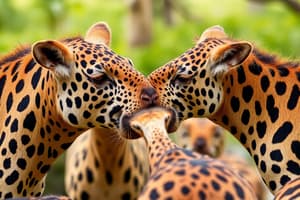Podcast
Questions and Answers
What factor increases the likelihood of non-kin responding to recruitment calls in vervet monkeys?
What factor increases the likelihood of non-kin responding to recruitment calls in vervet monkeys?
- Previous experience with other callers
- Receiving food prior to the call
- Being part of a larger group
- Recent grooming by the caller (correct)
How do chimpanzees primarily improve their chances of getting food from others?
How do chimpanzees primarily improve their chances of getting food from others?
- By vocalizing loudly
- By sharing their food first
- By grooming the food possessor recently (correct)
- By forming alliances with multiple members
What is the primary mechanism by which altruism is thought to evolve according to the information provided?
What is the primary mechanism by which altruism is thought to evolve according to the information provided?
- Through nonrandom social interactions (correct)
- Through competitive dominance hierarchies
- Through random genetic mutations
- Through group selection practices
What is the coefficient of relatedness between half siblings?
What is the coefficient of relatedness between half siblings?
What does nonrandom social interactions ultimately increase according to the take-home message?
What does nonrandom social interactions ultimately increase according to the take-home message?
What currency difference is noted regarding recruitment calls in vervets?
What currency difference is noted regarding recruitment calls in vervets?
According to Hamilton's rule, what must the benefit (b) be if the cost (c) is given and r = 0.125?
According to Hamilton's rule, what must the benefit (b) be if the cost (c) is given and r = 0.125?
What is described as a determinant of an individual's genetic contribution in the context of inclusive fitness?
What is described as a determinant of an individual's genetic contribution in the context of inclusive fitness?
Which method is NOT mentioned as a way for primates to recognize kin?
Which method is NOT mentioned as a way for primates to recognize kin?
What is the primary reason why altruism is directed towards kin according to Kin Selection theory?
What is the primary reason why altruism is directed towards kin according to Kin Selection theory?
What aspect of social behavior is highlighted in relation to chimps and their food sharing strategy?
What aspect of social behavior is highlighted in relation to chimps and their food sharing strategy?
What example of altruism in primates is provided to support kin selection theory?
What example of altruism in primates is provided to support kin selection theory?
What is a primary benefit of associating with other altruists according to the content?
What is a primary benefit of associating with other altruists according to the content?
How does relatedness facilitate the evolution of altruism in the hypothetical primate species?
How does relatedness facilitate the evolution of altruism in the hypothetical primate species?
In the hypothetical primate species, what is the frequency of callers among full siblings compared to the general population?
In the hypothetical primate species, what is the frequency of callers among full siblings compared to the general population?
What happens to the average fitness of callers when a call is given in the caller's group?
What happens to the average fitness of callers when a call is given in the caller's group?
What proportion of the hypothetical primate population are non-callers?
What proportion of the hypothetical primate population are non-callers?
What is the significance of the 50% chance that siblings share a given allele?
What is the significance of the 50% chance that siblings share a given allele?
What is indicated by the observation that 5 of 8 siblings in the caller’s group have the calling gene?
What is indicated by the observation that 5 of 8 siblings in the caller’s group have the calling gene?
Which option best describes the impact of genetic basis for calling on group dynamics?
Which option best describes the impact of genetic basis for calling on group dynamics?
What does the distribution of the calling gene in full siblings suggest about genetic inheritance?
What does the distribution of the calling gene in full siblings suggest about genetic inheritance?
How do caller and non-caller dynamics affect the evolutionary fitness in the described primate species?
How do caller and non-caller dynamics affect the evolutionary fitness in the described primate species?
What is the main effect of selection on individuals according to the content?
What is the main effect of selection on individuals according to the content?
In the hypothetical primate species example, what is the initial proportion of callers to non-callers?
In the hypothetical primate species example, what is the initial proportion of callers to non-callers?
What is suggested about the fitness of callers compared to non-callers in the example?
What is suggested about the fitness of callers compared to non-callers in the example?
How does natural selection view altruistic behaviors according to the content?
How does natural selection view altruistic behaviors according to the content?
What was the key insight offered by W.D. Hamilton regarding altruism?
What was the key insight offered by W.D. Hamilton regarding altruism?
What is a significant outcome of the relative fitness of callers and non-callers?
What is a significant outcome of the relative fitness of callers and non-callers?
In the context of natural selection and altruism, what does 'kin selection' refer to?
In the context of natural selection and altruism, what does 'kin selection' refer to?
What is a key characteristic of the hypothetical primate species regarding alarm calls?
What is a key characteristic of the hypothetical primate species regarding alarm calls?
What is indicated about non-callers in the hypothetical primate example?
What is indicated about non-callers in the hypothetical primate example?
What conclusion is drawn regarding group selection and altruism?
What conclusion is drawn regarding group selection and altruism?
What is the main benefit of calling according to kin selection?
What is the main benefit of calling according to kin selection?
According to Hamilton's Rule, which of the following represents the costs and benefits of an altruistic act?
According to Hamilton's Rule, which of the following represents the costs and benefits of an altruistic act?
What does the coefficient of relatedness (r) measure?
What does the coefficient of relatedness (r) measure?
What occurs when non-callers do not call within a group of full siblings?
What occurs when non-callers do not call within a group of full siblings?
When would calling be favored despite its costs?
When would calling be favored despite its costs?
If rb > c is satisfied, what can be inferred about the altruistic behavior?
If rb > c is satisfied, what can be inferred about the altruistic behavior?
What hypothesis does kin selection support regarding altruistic behavior?
What hypothesis does kin selection support regarding altruistic behavior?
How does calling impact the fitness of non-callers in comparison to the population at large?
How does calling impact the fitness of non-callers in comparison to the population at large?
In a group of 7/8 siblings, how do individuals typically share genes?
In a group of 7/8 siblings, how do individuals typically share genes?
Which of the following scenarios would likely decrease the frequency of altruistic calling in a population?
Which of the following scenarios would likely decrease the frequency of altruistic calling in a population?
Flashcards are hidden until you start studying
Study Notes
Altruism and Natural Selection
- Altruism can evolve through natural selection if altruists are more likely to associate with other altruists, whether kin or unrelated individuals.
- This increases inclusive fitness, which is the relative genetic contribution of an individual, plus the contribution of close relatives.
- Natural selection acts on individuals, and the effect on the group is not relevant to the individual’s fitness.
- In the case of alarm calls, non-callers have higher fitness than callers because they do not bear the cost of calling, and the benefits are shared by all recipients.
Kin Selection
- Kin selection is a theory that explains how altruistic behaviour can evolve in a population where individuals interact preferentially with relatives.
- Hamilton’s rule states that an altruistic act is favoured by natural selection when the benefit to the recipient (b) multiplied by the coefficient of relatedness (r) is greater than the cost to the giver (c).
- The coefficient of relatedness (r) is a measure of genetic relationship between interacting individuals, or the average probability that they share alleles from a common ancestor.
- Hamilton’s rule predicts that altruism should mainly be directed towards kin, because r = 0 for unrelated individuals.
- The closer the genetic relatedness, the more costly the altruism can be.
- For kin selection to work, primates must be able to recognize kin, which can be done through phenotypic matching (smell or likeness), or contextual cues (familiarity, proximity, observing patterns of associations).
Kin Recognition
- Maternal kin are easier to recognize through contextual clues, by associating with their mothers.
- Paternal kin are harder to identify, but in polygynous species, age-matched peers are likely fathered by the same male.
- Grooming is a behaviour that has evolved through kin selection because it is costly (time-consuming and decreases vigilance), but benefits hygiene and reinforces bonds.
Studying That Suits You
Use AI to generate personalized quizzes and flashcards to suit your learning preferences.




